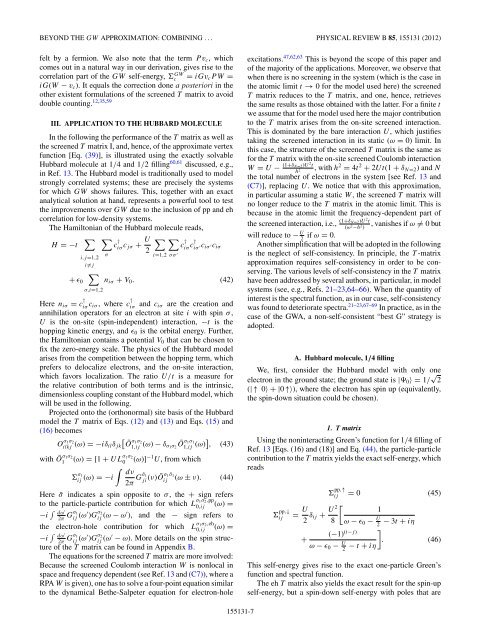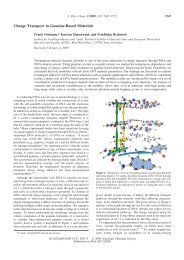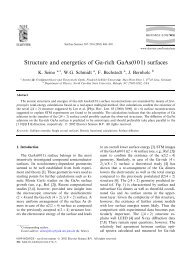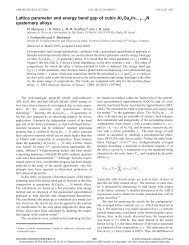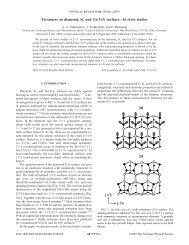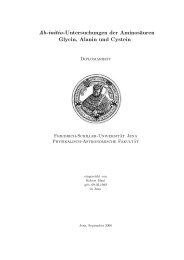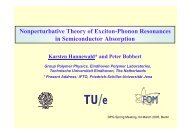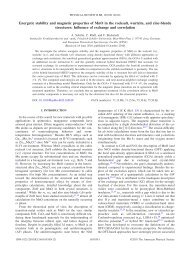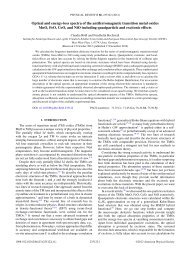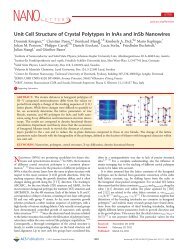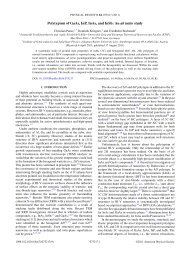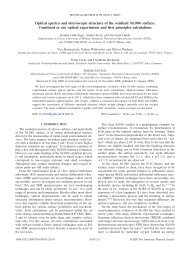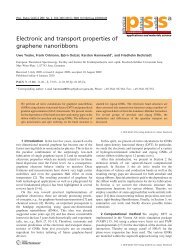Beyond the GW approximation - APS Link Manager - American ...
Beyond the GW approximation - APS Link Manager - American ...
Beyond the GW approximation - APS Link Manager - American ...
You also want an ePaper? Increase the reach of your titles
YUMPU automatically turns print PDFs into web optimized ePapers that Google loves.
BEYOND THE <strong>GW</strong> APPROXIMATION: COMBINING ... PHYSICAL REVIEW B 85, 155131 (2012)<br />
felt by a fermion. We also note that <strong>the</strong> term Pv c , which<br />
comes out in a natural way in our derivation, gives rise to <strong>the</strong><br />
correlation part of <strong>the</strong> <strong>GW</strong> self-energy, c <strong>GW</strong> = iGv c PW =<br />
iG(W − v c ). It equals <strong>the</strong> correction done a posteriori in <strong>the</strong><br />
o<strong>the</strong>r existent formulations of <strong>the</strong> screened T matrix to avoid<br />
double counting. 12,35,59<br />
III. APPLICATION TO THE HUBBARD MOLECULE<br />
In <strong>the</strong> following <strong>the</strong> performance of <strong>the</strong> T matrix as well as<br />
<strong>the</strong> screened T matrix I, and, hence, of <strong>the</strong> approximate vertex<br />
function [Eq. (39)], is illustrated using <strong>the</strong> exactly solvable<br />
Hubbard molecule at 1/4 and 1/2 filling 60,61 discussed, e.g.,<br />
in Ref. 13. The Hubbard model is traditionally used to model<br />
strongly correlated systems; <strong>the</strong>se are precisely <strong>the</strong> systems<br />
for which <strong>GW</strong> shows failures. This, toge<strong>the</strong>r with an exact<br />
analytical solution at hand, represents a powerful tool to test<br />
<strong>the</strong> improvements over <strong>GW</strong> due to <strong>the</strong> inclusion of pp and eh<br />
correlation for low-density systems.<br />
The Hamiltonian of <strong>the</strong> Hubbard molecule reads,<br />
∑ ∑<br />
H =−t c † iσ c jσ + U ∑ ∑<br />
2<br />
i,j=1,2<br />
i≠j<br />
+ ɛ 0<br />
∑<br />
σ,i=1,2<br />
σ<br />
i=1,2<br />
σσ ′ c † iσ c† iσ ′c iσ ′c iσ<br />
n iσ + V 0 . (42)<br />
Here n iσ = c † iσ c iσ, where c † iσ and c iσ are <strong>the</strong> creation and<br />
annihilation operators for an electron at site i with spin σ ,<br />
U is <strong>the</strong> on-site (spin-independent) interaction, −t is <strong>the</strong><br />
hopping kinetic energy, and ɛ 0 is <strong>the</strong> orbital energy. Fur<strong>the</strong>r,<br />
<strong>the</strong> Hamiltonian contains a potential V 0 that can be chosen to<br />
fix <strong>the</strong> zero-energy scale. The physics of <strong>the</strong> Hubbard model<br />
arises from <strong>the</strong> competition between <strong>the</strong> hopping term, which<br />
prefers to delocalize electrons, and <strong>the</strong> on-site interaction,<br />
which favors localization. The ratio U/t is a measure for<br />
<strong>the</strong> relative contribution of both terms and is <strong>the</strong> intrinsic,<br />
dimensionless coupling constant of <strong>the</strong> Hubbard model, which<br />
will be used in <strong>the</strong> following.<br />
Projected onto <strong>the</strong> (orthonormal) site basis of <strong>the</strong> Hubbard<br />
model <strong>the</strong> T matrix of Eqs. (12) and (13) and Eqs. (15) and<br />
(16) becomes<br />
O σ 1σ 2<br />
ilkj (ω) =−iδ [Ōσ<br />
1 σ 2<br />
ilδ jk 1,ij (ω) − δ σ 1 σ 2 Ō σ 1σ 1<br />
1,ij (ω)] , (43)<br />
with Ō σ 1σ 2<br />
1<br />
(ω) = [1 + UL σ 1σ 2<br />
0<br />
(ω)] −1 U, from which<br />
dν<br />
2π G ¯σ 1<br />
ji (ν)Ōσ 1 ¯σ 1<br />
ij<br />
(ω ± ν). (44)<br />
Here ¯σ indicates a spin opposite to σ ,<strong>the</strong>+ sign refers<br />
to <strong>the</strong> particle-particle contribution for which L σ 1σ 2 ,pp<br />
0,ij<br />
(ω) =<br />
σ 1<br />
ij (ω) =−i ∫<br />
2π Gσ 1<br />
−i ∫ dω ′<br />
2π Gσ 1<br />
ij (ω′ )G σ 2<br />
ij (ω − ω′ ), and <strong>the</strong> − sign refers to<br />
<strong>the</strong> electron-hole contribution for which L σ 1σ 2 ,eh<br />
0,ij<br />
(ω) =<br />
−i ∫ dω ′<br />
ij (ω′ )G σ 2<br />
ij (ω′ − ω). More details on <strong>the</strong> spin structure<br />
of <strong>the</strong> T matrix can be found in Appendix B.<br />
The equations for <strong>the</strong> screened T matrix are more involved:<br />
Because <strong>the</strong> screened Coulomb interaction W is nonlocal in<br />
space and frequency dependent (see Ref. 13 and (C7)), where a<br />
RPA W is given), one has to solve a four-point equation similar<br />
to <strong>the</strong> dynamical Be<strong>the</strong>-Salpeter equation for electron-hole<br />
excitations. 47,62,63 This is beyond <strong>the</strong> scope of this paper and<br />
of <strong>the</strong> majority of <strong>the</strong> applications. Moreover, we observe that<br />
when <strong>the</strong>re is no screening in <strong>the</strong> system (which is <strong>the</strong> case in<br />
<strong>the</strong> atomic limit t → 0 for <strong>the</strong> model used here) <strong>the</strong> screened<br />
T matrix reduces to <strong>the</strong> T matrix, and one, hence, retrieves<br />
<strong>the</strong> same results as those obtained with <strong>the</strong> latter. For a finite t<br />
we assume that for <strong>the</strong> model used here <strong>the</strong> major contribution<br />
to <strong>the</strong> T matrix arises from <strong>the</strong> on-site screened interaction.<br />
This is dominated by <strong>the</strong> bare interaction U, which justifies<br />
taking <strong>the</strong> screened interaction in its static (ω = 0) limit. In<br />
this case, <strong>the</strong> structure of <strong>the</strong> screened T matrix is <strong>the</strong> same as<br />
for <strong>the</strong> T matrix with <strong>the</strong> on-site screened Coulomb interaction<br />
W = U − (1+δ N=2)U 2 t<br />
, with h 2 = 4t 2 + 2Ut(1 + δ<br />
h 2<br />
N=2 ) and N<br />
<strong>the</strong> total number of electrons in <strong>the</strong> system [see Ref. 13 and<br />
(C7)], replacing U. We notice that with this <strong>approximation</strong>,<br />
in particular assuming a static W, <strong>the</strong> screened T matrix will<br />
no longer reduce to <strong>the</strong> T matrix in <strong>the</strong> atomic limit. This is<br />
because in <strong>the</strong> atomic limit <strong>the</strong> frequency-dependent part of<br />
<strong>the</strong> screened interaction, i.e., (1+δ N=2)U 2 t<br />
, vanishes if ω ≠ 0but<br />
(ω 2 −h 2 )<br />
will reduce to − U if ω = 0.<br />
2<br />
Ano<strong>the</strong>r simplification that will be adopted in <strong>the</strong> following<br />
is <strong>the</strong> neglect of self-consistency. In principle, <strong>the</strong> T -matrix<br />
<strong>approximation</strong> requires self-consistency in order to be conserving.<br />
The various levels of self-consistency in <strong>the</strong> T matrix<br />
have been addressed by several authors, in particular, in model<br />
systems (see, e.g., Refs. 21–23,64–66). When <strong>the</strong> quantity of<br />
interest is <strong>the</strong> spectral function, as in our case, self-consistency<br />
was found to deteriorate spectra. 21–23,67–69 In practice, as in <strong>the</strong><br />
case of <strong>the</strong> <strong>GW</strong>A, a non-self-consistent “best G” strategy is<br />
adopted.<br />
A. Hubbard molecule, 1/4 filling<br />
We, first, consider <strong>the</strong> Hubbard model with only one<br />
electron in <strong>the</strong> ground state; <strong>the</strong> ground state is | 0 〉=1/ √ 2<br />
(|↑ 0〉+|0↑〉), where <strong>the</strong> electron has spin up (equivalently,<br />
<strong>the</strong> spin-down situation could be chosen).<br />
1. T matrix<br />
Using <strong>the</strong> noninteracting Green’s function for 1/4 filling of<br />
Ref. 13 [Eqs. (16) and (18)] and Eq. (44), <strong>the</strong> particle-particle<br />
contribution to <strong>the</strong> T matrix yields <strong>the</strong> exact self-energy, which<br />
reads<br />
pp,↑<br />
pp,↓<br />
ij<br />
= U 2 δ ij + U 2<br />
8<br />
+<br />
ij<br />
= 0 (45)<br />
[<br />
1<br />
ω − ɛ 0 − U − 3t + iη<br />
2<br />
(−1) (i−j) ]<br />
ω − ɛ 0 − U 2 − t + iη . (46)<br />
This self-energy gives rise to <strong>the</strong> exact one-particle Green’s<br />
function and spectral function.<br />
The eh T matrix also yields <strong>the</strong> exact result for <strong>the</strong> spin-up<br />
self-energy, but a spin-down self-energy with poles that are<br />
155131-7


